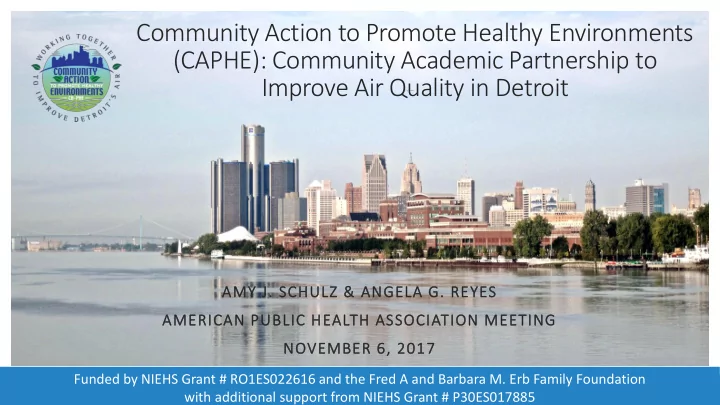

Community Action to Promote Healthy Environments (CAPHE): Community Academic Partnership to Improve Air Quality in Detroit AMY J. SCHULZ & ANGELA G. REYES AMERICAN PUBLIC HEALTH ASSOCIATION MEETING NOVEMBER 6, 2017 Funded by NIEHS Grant # RO1ES022616 and the Fred A and Barbara M. Erb Family Foundation with additional support from NIEHS Grant # P30ES017885
CO-AUTHORS: Amy J. Schulz 1 , Graciela B. Mentz 1 , Larissa Larson 2 , Natalie Sampson 3 , Angela Reyes 4 , Simone Sagovac 5 1. University of Michigan School of Public Health 2. University of Michigan Taubman School of Architecture and Urban Planning 3. University of Michigan Dearborn 4. Detroit Hispanic Development Corporation 5. Southwest Detroit Community Benefits Coalition
PRESENTER DISCLOSURE Amy Schulz & Angie Reyes (Co-Presenters) The following personal financial relationships with commercial interests relevant to this presentation existed in the past twelve (12) months: NO RELATIONSHIPS TO DISCLOSE
PRESENTER DISCLOSURE Amy Schulz & Angie Reyes (Co-Presenters) Our presentation will include discussion of the “off - label” use of the following: NO RELATIONSHIPS TO DISCLOSE
Partner Organizations & Partnerships
Air Quality in Detroit • Historically, Detroit has faced challenges with air quality • Multiple pollutant sources • Large exposed population • Adverse health outcomes associated with air pollutants • Vulnerable communities • Opportunity to improve air quality and reduce health inequities
Air Quality in Detroit • Historically, Detroit has faced challenges with air quality • Multiple pollutant sources • Large exposed population • Adverse health outcomes associated with air pollutants • Vulnerable communities • Opportunity to improve air quality and reduce health inequities Photo 1: Incinerator, Detroit Renewable Power, Detroiters Working for Environmental Justice, 1-4-16 Photo 2: Truck Traffic, Detroit, Hannah Gordon, 6-18-15
Objective: To Inform a Public Health Action Plan to reduce environmental exposures and health risks We examined: 1) Distribution of exposures and protective factors by population characteristics; 2) Associations of exposures and protective factors with cardiopulmonary mortality (CPM); and 3) Reductions in CPM with reductions in exposure and increases in tree canopy in the Detroit Metropolitan Area (DMA).
Methods: Data and Measures Dependent Variable: Cardiopulmonary Mortality: (ICD-10 codes for cardiovascular disease, I10-I70, and respiratory disease, J00-J99). All deaths recorded in census tracts in Michigan, 2008-2012. Independent variable (census tract level, rank ordered 1=low, 5=high): Exposure and health risk: Diesel PM, cancer and respiratory risk from 2011 NATA data. Population vulnerability: Percent people of color, poverty, renters, education<h.s., median household value, <5, >60, linguistic isolation Tree canopy coverage: Percent tree coverage Independent variable (individual level) Proximity to heavily trafficked roadways: residential address <150 meters=1, >=150 meters=0
.
Cumulative Risk: Exposure + Vulnerability AIM 2: Identifying priority communities for action Schulz, Mentz, Sampson et al, 2016. Race and the distribution of social and physical environmental risk. Under review.
Prioritizing tree planting locations Larson, L. Prioritizing Tree Planting Locations to Enhance Air Pollution Removal along Detroit’s Roadways
Methods: Analysis Random intercept multilevel, multivariate longitudinal analyses 𝑀𝑓𝑤𝑓𝑚 1 𝑄𝑠𝑝𝑐 𝐷𝑄𝑁 = 1 = 𝜚, 𝜚 (1−𝜚) ] = 𝜃 Log[ 𝜃 = 𝛾 0 + 𝛾 1 ∗ (𝐽 <150 ) + 𝛾 2 ∗ (𝐽 ≥150 𝑏𝑜𝑒<300 ) + 𝛾 3 ∗ 𝑑𝑝𝑤𝑏𝑠𝑗𝑏𝑢𝑓𝑡 … 𝑀𝑓𝑤𝑓𝑚 2 𝛾 0 = 𝛿 00 + 𝑣 0 Account for spatial variation as well as longitudinal trends
Cardiopulmonary Mortality regressed on exposure and health risk, social vulnerability, tree canopy coverage, and living within 150 meters of a heavily trafficked roadway, controlling for age, education, race and smoking as contributor to cause of death Community Action to Promote Healthy Environments (CAPHE) February 1 st , 2017
Health Impacts of Potential Actions • Greatest reductions in Cardiopulmonary Mortality (CPB) achieved by reducing diesel PM to two lowest quintiles in all census tracts • Increasing tree canopy coverage to the levels in the two highest quintiles achieved the second greatest reduction in CPM • Creating buffers around heavily trafficked roadways (e.g. all residential areas >=150 meters from roadway) achieved some reduction in mortality, but less than the above two. • In part because relatively low population density within 150 meters of freeways.
CAPHE Public Health Action Plan Recommendations 1. Expand diesel retrofit & fleet & engine replacement efforts 2. Increase awareness of existing anti-idling efforts 3. Increase enforcement of existing anti-idling ordinances 4. Incentivize trucking, delivery and bus companies & drivers to minimize idling 5. Increase tree canopy coverage throughout Detroit City 6. Plant vegetative buffers and/or install sound walls where current minimum setbacks are not met 7. Adopt regulations to create minimum setbacks between people and pollution sources
Community Benefits Coalition 1. INSERT HERE THE MAP OF THE SW AREA WITH 150 METER BUFFER AND CHILDREN BELOW 5 AND DISCUSS HOW THIS MAP WAS USED AS PART OF THE COMMUNITY BENEFITS AGREEMENT
Partner Organizations & Partnerships Contact: Kristina Rice, Project Manager, klrice@umich.edu
Recommend
More recommend